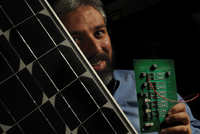A parallel process to boost solar power
Posted by magazine
The usual method of connecting solar panels is in a series, one after the other. But just as one bad bulb in a string of Christmas lights can black out the entire set, so can a single solar panel disrupt the flow of electrical current through the other panels in a series.
“If one of the panels is shaded, dirty or damaged, it affects them all,” says Jonathan Kimball, assistant professor of electrical and computer engineering. “The conventional approach to solar arrays inherently limits the amount of power they produce if there’s any variation in the panels.”

Jonathan Kimball, assistant professor of electrical and computer engineering at Missouri S&T, is working to improve the efficiency of solar arrays by connecting solar panels in parallel, rather than in a series.
Rather than connecting solar panels in a series — where the electrical current must flow from one panel to get to the next — Kimball suggests parallel wiring for the panels. The parallel approach would connect each panel to its own power converter instead of sending the electrical current through a series of panels to a single converter.
Kimball is working on two different projects in this area. Through one project, funded by the U.S. Army’s Leonard Wood Institute, based in nearby Fort Leonard Wood, Mo., he is developing a system that could be used for a forward operating base. The other project, funded by the National Science Foundation, is focused on developing a system that could be used for residential power.